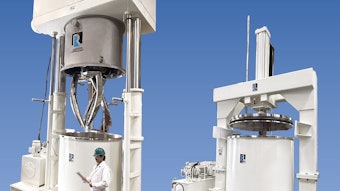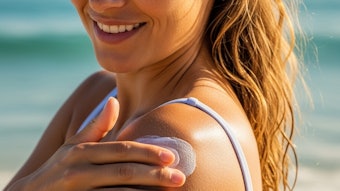
(For the complete article, click through to the May 2019 digital edition.)
Dry mask product forms are based on three fundamental technologies that have revolutionized the cosmetic industry in the past 10 to 15 years: cosmetotextiles, active ingredient delivery systems and sheet masks. Combining and optimizing these innovations allows for synergized benefits, and has emerged as a new way to apply skin care products for enhanced efficacy (see Figure 1a-b). This article considers what these technologies can lend to dry mask innovation and how to optimize them; the resulting dry masks were then put to the test in vitro and clinically.
Dry Mask Foundation
Cosmetotextiles: A cosmetotextile is a textile article that contains a substance or a preparation that is intended to be released sustainably onto the different superficial parts of the human body, especially the skin, and which claims particular properties such as cleansing, perfuming, change of appearance, protection, maintenance in good condition, or correction of body odors, according to the French Bureau de Normalisation des Industries Textiles et de l’Habillement.1
When introduced on the market, this innovation not only provided functionality but also ensured that the preparation containing solid microcapsules was released through the stretching of the textile itself and friction against the skin. Albeit promising, this technology quickly encountered a few limitations—some studies revealed toxic potential and allergic reactions due to the nature of the microcapsule’s shell and the excessive and irregular amount of substance left on the skin after release.2
Active ingredient delivery: Numerous delivery systems are currently available, such as liposomes, polymeric particles and molecular complexes, to help active ingredients penetrate the skin.3, 4 These systems vary in structure, size and mechanism with which they interact with skin.5 Although first considered for pharmaceutical applications, these vectors were introduced into cosmetics and they considerably improved product efficacy. They quickly became a major innovation for the beauty industry.
Despite their unquestionable value for enhancing skin penetration, traditional delivery systems are limited in terms of the number and solubility of the actives they can contain. For example, the contained actives must have the same lipid- or water-solubility, and cocktails of ingredients can rarely coexist within the same delivery system.
Sheet masks: Sheet masks are a relative newcomer to the skin care industry. First extremely popular in Asia, they have been winning international popularity since 2015. Sheet masks can be made of paper, fiber, cotton, cellulose, foils or coconut pulp sheets, and are soaked in skin care liquid. The products are packaged individually and are intended for single use only. Their appeal is based on the close contact they make with skin, reducing water evaporation and enhancing active ingredient penetration. However, since the liquid has an important aqueous phase, this can potentially accelerate the degradation rate of unstable ingredients6 or, in some cases, the growth of bacteria.
The transfer of microparticles to the skin is modulated by parameters such as textile stretch, body heat, movement and massage.
Dry Mask Development
As noted, the development of dry masks originated from the potential of these different technologies and trends. The key objective of the described work was therefore to look for ways to overcome their inherent limitations, for more efficient and innovative product development and to answer the growing demand for masks; especially sheet masks. In fact, Datamonitor estimates the mask market value will reach €6.6 billion (US $7.47 billion) by 2020, with a CAGR of 8.1% between 2015–2020. It also has been projected that in 20 years, 80% of textiles will be technically adapted or functionalized in some manner.1
Nonwoven dry masks can be considered a close cousin to cosmetotextiles because they incorporate ingredients into a textile form. The present invention, however, also leverages two patented technologies: a skin-mimicking microparticle delivery system, and a patented, dry-touch application process.
Microparticles: The microparticles are composed of lipid-based ingredients to mimic the skin’s composition, and are readily compatible with the skin. Fatty acids, triglycerides and sterols are naturally present in skin, so by supplying these ingredients, the delivery system could itself help to restore the skin barrier. Furthermore, through careful optimization of not only their composition but also the preparation process, the particles also can incorporate actives of different origins, physicochemical properties and solubilities. Figure 2a-b shows the colocalization of coumarin-6 and rhodamine B fluorophores, as markers for lipophilic and hydrophilic active ingredients, coincorporated in the particles.
Thus, the particles primarily fulfill two topical application objectives: to modulate or assist the barrier function of the skin, and to administer active ingredient(s) to one or more skin layers or compartments.
Dry-touch application process: The dry masks are obtained by applying the prepared microparticles onto a textile via a patented process that results in a dry-to-the-touch feel. This process enables the customization of shape, pattern, color and formulation for various cosmetic and, potentially, pharmaceutical applications. Figure 1a depicts one such dry mask featuring a pink formula applied in a scallop pattern.
When the mask is worn, the microparticles are gradually transferred to the skin by parameters such as textile stretch, body heat, movement and massage (see Figure 3 schematic). Upon contact with the skin, the microparticles are destabilized by body temperature and friction while at the same time their lipid matrix merges with the skin’s, releasing the payload of active ingredients. Dry masks do not require water, they are used as is, in anhydrous form.
In the context of an anti-aging cosmetic, the present article evaluates how a combination of the microparticles with active payloads in the waterless textile mask could enhance active ingredient penetration and, therefore, finished product efficacy.











